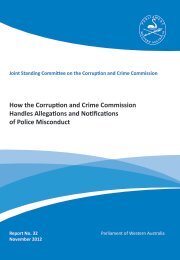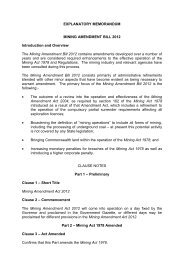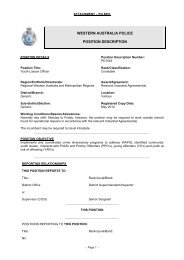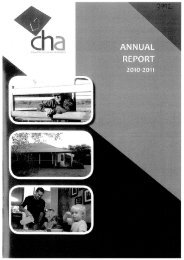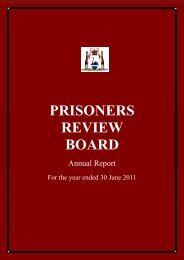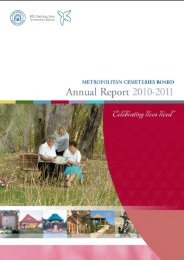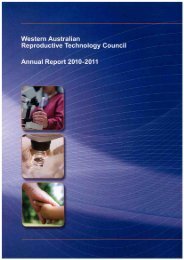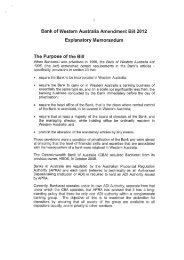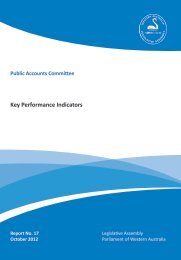Port Hedland Port Authority Annual Report 2011 - Parliament of ...
Port Hedland Port Authority Annual Report 2011 - Parliament of ...
Port Hedland Port Authority Annual Report 2011 - Parliament of ...
You also want an ePaper? Increase the reach of your titles
YUMPU automatically turns print PDFs into web optimized ePapers that Google loves.
Note 20. Financial Instruments<br />
(a)<br />
Financial Risk Management Objectives and Policies<br />
Financial instruments held by the <strong>Authority</strong> are cash and cash equivalents, term deposits, loans, Treasurer’s<br />
advances and receivables and payables. The <strong>Authority</strong> has limited exposure to financial risks. The <strong>Authority</strong>’s<br />
overall risk management program focuses on managing the risks identified below.<br />
Credit risk<br />
Credit risk arises when there is the possibility <strong>of</strong> the <strong>Authority</strong>’s receivables defaulting on their contractual<br />
obligations resulting in financial loss to the <strong>Authority</strong>. The <strong>Authority</strong> measures credit risk on a fair value basis and<br />
monitors risk on a regular basis.<br />
The maximum exposure to credit risk at Statement <strong>of</strong> Financial Position date in relation to each class <strong>of</strong> recognised<br />
financial assets is the gross carrying amount <strong>of</strong> those assets inclusive <strong>of</strong> any provisions for impairment, as shown in<br />
the table at Note 11.<br />
The <strong>Authority</strong> trades only with recognised, creditworthy third parties. The <strong>Authority</strong> has policies in place to ensure<br />
that sales <strong>of</strong> products and services are made to customers with an appropriate credit history. In addition,<br />
receivable balances are monitored on an ongoing basis with the result that the <strong>Authority</strong>’s exposure to bad debts<br />
is minimal. There are no significant concentrations <strong>of</strong> credit risk.<br />
The <strong>Authority</strong> has very low levels <strong>of</strong> default. All overdue accounts are reviewed monthly by the Board and legal<br />
action instigated if necessary. There has only been one case where this action was necessary in the current year<br />
and none in the prior year.<br />
Provision for impairment <strong>of</strong> financial assets is calculated based on past experience, and current and expected<br />
changes in client credit ratings. For financial assets that are either past due or impaired, refer to Note 11<br />
‘Receivables’.<br />
The <strong>Authority</strong>’s credit risk management is further supported by rental agreements and sections 116 & 117 <strong>of</strong> the<br />
<strong>Port</strong> Authorities Act 1999. Section 116 refers to the liability to pay port charges in respect <strong>of</strong> vessels and Section<br />
117 refers to the liability to pay port charges in respect <strong>of</strong> goods. <strong>Port</strong> charges are defined in Section 115.<br />
Liquidity risk<br />
The <strong>Authority</strong> is exposed to liquidity risk through its trading in the normal course <strong>of</strong> business. Liquidity risk arises<br />
when the <strong>Authority</strong> is unable to meet its financial obligations as they fall due. The <strong>Authority</strong>’s objective is to<br />
maintain a balance between continuity <strong>of</strong> funding and flexibility through the use <strong>of</strong> bank overdrafts, loans and<br />
finance leases. The <strong>Authority</strong> has appropriate procedures to manage cash flows by monitoring forecast cash flows<br />
to ensure that sufficient funds are available to meet its commitments.<br />
Market risk<br />
The <strong>Authority</strong> does not trade in foreign currency and is not materially exposed to other price risks (for example,<br />
equity securities or commodity prices changes). The <strong>Authority</strong>’s exposure to market risk for changes in interest<br />
rates relate primarily to the long-term debt obligations. The <strong>Authority</strong>’s borrowings are all obtained through the<br />
Western Australian Treasury Corporation (WATC) and are at fixed rates with varying maturities. The risk is<br />
managed by WATC through portfolio diversification and variation in maturity dates. Other than as detailed in the<br />
Interest rate sensitivity analysis table, the <strong>Authority</strong> has limited exposure to interest rate risk because it has no<br />
borrowings other than WATC borrowings.<br />
Page 73



